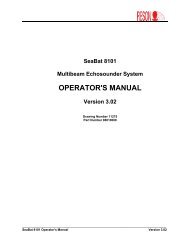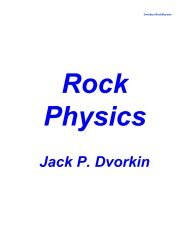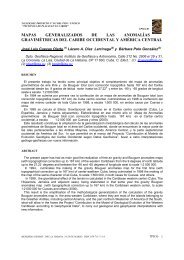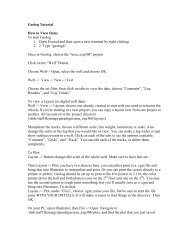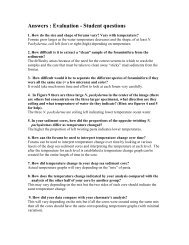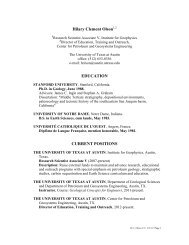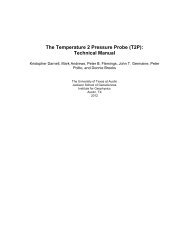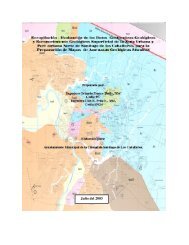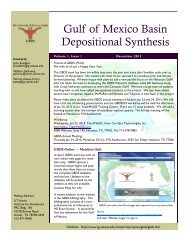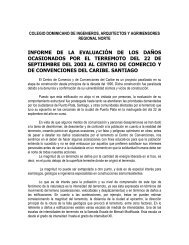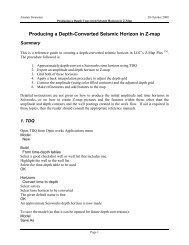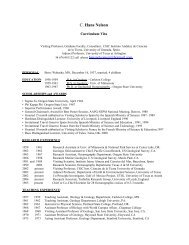PDF files of the National Science Standards
PDF files of the National Science Standards
PDF files of the National Science Standards
You also want an ePaper? Increase the reach of your titles
YUMPU automatically turns print PDFs into web optimized ePapers that Google loves.
early grades, instruction should establish <strong>the</strong>meaning and use <strong>of</strong> unifying concepts andprocesses—for example, what it means tomeasure and how to use measurement tools.At <strong>the</strong> upper grades, <strong>the</strong> standard shouldfacilitate and enhance <strong>the</strong> learning <strong>of</strong> scientificconcepts and principles by providingstudents with a big picture <strong>of</strong> scientificideas—for example,how measurement isimportant in all scientific endeavors.SCIENCE AS INQU I RY STA N D A R D SIn <strong>the</strong> vision presented by <strong>the</strong> <strong>Standards</strong>,inquiry is a step beyond “science as aprocess,” in which students learn skills, suchas observation, inference, and experimentation.The new vision includes <strong>the</strong> “processes<strong>of</strong> science” and requires that students combineprocesses and scientific knowledge as<strong>the</strong>y use scientific reasoning and criticalthinking to develop <strong>the</strong>ir understanding <strong>of</strong>science. Engaging students in inquiry helpsstudents develop■■■Understanding <strong>of</strong> scientific concepts.An appreciation <strong>of</strong> “how we know” whatwe know in science.Understanding <strong>of</strong> <strong>the</strong> nature <strong>of</strong> science.■Skills necessary to become independentinquirers about <strong>the</strong> natural world.■ The dispo s i ti ons to use <strong>the</strong> skill s ,a bi l i ti e s ,and atti tu des assoc i a ted with scien ce .<strong>Science</strong> as inquiry is basic to science educationand a controlling principle in <strong>the</strong>ultimate organization and selection <strong>of</strong> students’activities. The standards on inquiryhighlight <strong>the</strong> ability to conduct inquiry anddevelop understanding about scientificinquiry. Students at all grade levels and inevery domain <strong>of</strong> science should have <strong>the</strong>opportunity to use scientific inquiry anddevelop <strong>the</strong> ability to think and act in waysassociated with inquiry, including askingquestions,planning and conducting investigations,usingappropriate tools and techniquesto ga<strong>the</strong>r data, thinking critically andlogically about relationships between evidenceand explanations, constructing andanalyzing alternative explanations, and communicatingscientific arguments. Table 6.1shows <strong>the</strong> standards for inquiry. The scienceas inquiry standards are described in terms<strong>of</strong> activities resulting in student development<strong>of</strong> certain abilities and in terms <strong>of</strong> studentunderstanding <strong>of</strong> inquiry.TA B L E 6 . 1 .S C I E N C E A S I N Q U I R Y S TA N D A R D SLEVELS K-4Abilities necessary to doscientific inquiryUnderstanding aboutscientific inquiryLEVELS 5-8Abilities necessary to doscientific inquiryUnderstanding aboutscientific inquiryLEVELS 9-12Abilities necessary to doscientific inquiryUnderstanding aboutscientific inquiry6 S C I E N C E C O N T E N T S T A N D A R D S 1 0 5
PH YS I CAL SCIENCE, LIFE SCIENCE,AND EARTH AND SPACE SCIENCES TA N D A R D SThe standards for physical scien ce ,l i fe science , and earth and space scien ce de s c ri be<strong>the</strong> su bj ect matter <strong>of</strong> s c i en ce using threewi dely accepted divi s i ons <strong>of</strong> <strong>the</strong> domain <strong>of</strong>s c i en ce . S c i en ce su bj ect matter focuses on<strong>the</strong> scien ce fact s , con cept s , pri n c i p l e s , t h eorie s , and models that are important for alls tu dents to know, u n ders t a n d , and use.Ta bles 6.2, 6 . 3 , and 6.4 are <strong>the</strong> standards forphysical scien ce ,l i fe scien ce , and earth ands p ace scien ce , re s pectively.SCIENCE AND T E C H N O LO G YS TA N D A R D SThe scien ce and tech n o l ogy standards inTa ble 6.5 establish con n ecti ons bet ween <strong>the</strong>n a tu ral and de s i gn ed worlds and provi de studentswith opportu n i ties to devel opdec i s i on-making abi l i ti e s . Th ey are not standa rds for tech n o l ogy edu c a ti on ; ra t h er, t h e s es t a n d a rds em ph a s i ze abi l i ties assoc i a ted wi t h<strong>the</strong> process <strong>of</strong> de s i gn and fundamen t a lu n ders t a n d i n gs abo ut <strong>the</strong> en terprise <strong>of</strong> s c i-en ce and its va rious linkages with tech n o l ogy.As a complement to <strong>the</strong> abilities developedin <strong>the</strong> science as inquiry standards,TA B L E 6 . 2 .P H YS I C A L S C I E N C E S TA N D A R D SLEVELS K-4Properties <strong>of</strong> objects andmaterialsPosition and motion <strong>of</strong> objectsLight,heat, electricity,and magnetismLEVELS 5-8Properties and changes <strong>of</strong>properties in matterMotions and forcesTransfer <strong>of</strong> energyLEVELS 9-12Structure <strong>of</strong> atomsStructure and properties <strong>of</strong>matterChemical reactionsMotions and forcesConservation <strong>of</strong> energy andincrease in disorderInteractions <strong>of</strong> energy and matterTA B L E 6 . 3 .L I F E S C I E N C E S TA N D A R D SLEVELS K-4Characteristics <strong>of</strong> organismsLife cycles <strong>of</strong> organismsOrganisms and environmentsLEVELS 5-8Structure and function in livingsystemsReproduction and heredityRegulation and behaviorPopulations and ecosystemsDiversity and adaptations <strong>of</strong>organismsLEVELS 9-12The cellMolecular basis <strong>of</strong> heredityBiological evolutionInterdependence <strong>of</strong> organismsMatter, energy, and organizationin living systemsBehavior <strong>of</strong> organisms1 0 66 S C I E N C E C O N T E N T S T A N D A R D S
<strong>the</strong>se standards call for students to developabilities to identify and state a problem,design a solution—including a cost andrisk-and-benefit analysis—implement asolution,and evaluate <strong>the</strong> solution.<strong>Science</strong> as inquiry is parallel to technologyas design. Both standards emphasize studentdevelopment <strong>of</strong> abilities and understanding.Connections to o<strong>the</strong>r domains,such as ma<strong>the</strong>matics, are clarified inChapter 7, Program <strong>Standards</strong>.SCIENCE IN PERSONAL AND SOCIALPE R S PECTIVES STA N D A R D SAn important purpose <strong>of</strong> science educationis to give students a means to understandand act on personal and social issues.The science in personal and social perspectivesstandards help students developdecision-making skills. Understandingsassociated with <strong>the</strong> concepts in Table 6.6give students a foundation on which tobase decisions <strong>the</strong>y will face as citizens.H I S TO RY AND NATURE OF SCIENCES TA N D A R D SIn learning scien ce ,s tu dents need tou n derstand that scien ce ref l ects its historyand is an on goi n g, ch a n ging en terpri s e . Th es t a n d a rds for <strong>the</strong> history and natu re <strong>of</strong> s c i-en ce recom m end <strong>the</strong> use <strong>of</strong> h i s tory in sch oo ls c i en ce programs to cl a rify different aspect s<strong>of</strong> s c i en tific inqu i ry, <strong>the</strong> human aspects <strong>of</strong>s c i en ce , and <strong>the</strong> role that scien ce has playedin <strong>the</strong> devel opm ent <strong>of</strong> va rious cultu re s . Ta bl e6.7 provi des an overvi ew <strong>of</strong> this standard .TA B L E 6 . 4 .E A R T H A N D S PA C E S C I E N C E S TA N D A R D SLEVELS K-4Properties <strong>of</strong> earth materialsObjects in <strong>the</strong> skyChanges in earth and skyLEVELS 5-8Structure <strong>of</strong> <strong>the</strong> earth systemEarth’s historyEarth in <strong>the</strong> solar systemLEVELS 9-12Energy in <strong>the</strong> earth systemGeochemical cyclesOrigin and evolution <strong>of</strong> <strong>the</strong>earth systemOrigin and evolution <strong>of</strong> <strong>the</strong>universeTA B L E 6 . 5 .S C I E N C E A N D T E C H N O L O G Y S TA N D A R D SLEVELS K-4Abilities to distinguish betweennatural objects and objectsmade by humansAbilities <strong>of</strong> technological designUnderstanding about science andtechnologyLEVELS 5-8Abilities <strong>of</strong> technological designUnderstanding about scienceand technologyLEVELS 9-12Abilities <strong>of</strong> technological designUnderstanding about science andtechnology6 S C I E N C E C O N T E N T S T A N D A R D S 1 0 7
TA B L E 6 . 6 .S C I E N C E I N P E R S O N A L A N D S O C I A L P E R S PE C T I V E SLEVELS K-4Personal healthCharacteristics and changes inpopulationsTypes <strong>of</strong> resourcesChanges in environments<strong>Science</strong> and technology in localchallengesLEVELS 5-8Personal healthPopulations, resources,andenvironmentsNatural hazardsRisks and benefits<strong>Science</strong> and technology insocietyLEVELS 9-12Personal and community healthPopulation growthNatural resourcesEnvironmental qualityNa t u ral and hu m a n - i n du cedh a z a rd sS c i en ce and tech n o l ogy in loc a l ,n a ti on a l , and gl obal ch a ll en ge sTA B L E 6 . 7 .H I S TO R Y A N D N AT U R E O F S C I E N C E S TA N D A R D SLEVELS K-4<strong>Science</strong> as a human endeavorLEVELS 5-8<strong>Science</strong> as a human endeavorNature <strong>of</strong> scienceHistory <strong>of</strong> scienceLEVELS 9-12<strong>Science</strong> as a human endeavorNature <strong>of</strong> scientific knowledgeHistorical perspectivesFo rm <strong>of</strong> <strong>the</strong>Co nte nt St a n d a rd sBelow is an example <strong>of</strong> a content standard.Each content standard states that, as <strong>the</strong>result <strong>of</strong> activities provided for all studentsin <strong>the</strong> grade level discussed,<strong>the</strong> content <strong>of</strong><strong>the</strong> standard is to be understood or <strong>the</strong> abilitiesare to be developed.PH YS I CAL SCIENCE (EXA M P L E )CONTENT STANDARD B:As a result <strong>of</strong> <strong>the</strong> activities ing rades K-4, all students shouldd evelop an understanding <strong>of</strong>■■■Properties <strong>of</strong> objects and materialsPosition and motion <strong>of</strong> objectsLi g ht, h e at, e l e ct ri c i ty, and magnetismAf ter each con tent standard is a secti onen ti t l ed , D evel oping Student Un der s t a n d i n g( or abi l i ties and unders t a n d i n g, wh en appropria te ), wh i ch el a bora tes upon issues assoc i-a ted with opportu n i ties to learn <strong>the</strong> con ten t .This secti on de s c ri bes linkages among studentlearn i n g, te ach i n g, and cl a s s room situ a-ti on s . This discussion on devel oping stu den tu n ders t a n d i n g, i n cluding <strong>the</strong> rem a rks on <strong>the</strong>s el ecti on <strong>of</strong> con tent for grade level s , is basedin part on edu c a ti onal re s e a rch . It also incorporates <strong>the</strong> ex peri en ces <strong>of</strong> m a ny though tf u lpeop l e , i n cluding te ach ers , te ach er edu c a-tors ,c u rri c u lum devel opers , and edu c a ti on a lre s e a rch ers .( Some referen ces to re s e a rch ons tu dent understanding and abi l i ties arel oc a ted at <strong>the</strong> end <strong>of</strong> <strong>the</strong> ch a pter. )The next section <strong>of</strong> each standard is aGuide to <strong>the</strong> Content Standard, which1 0 86 S C I E N C E C O N T E N T S T A N D A R D S
describes <strong>the</strong> fundamental ideas that underlie<strong>the</strong> standard. Content is fundamental if it■■■■■■■Represents a central event or phenomenonin <strong>the</strong> natural world.Represents a central scientific idea andorganizing principle.Has rich explanatory power.Guides fruitful investigations.Applies to situations and contextscommon to everyday experiences.Can be linked to meaningfullearning experiences.Is developmentally appropriate forstudents at <strong>the</strong> grade level specified.Cri te ria for <strong>the</strong>Co nte nt St a n d a rd sThree criteria influence <strong>the</strong> selection <strong>of</strong>science content. The first is an obligation to<strong>the</strong> domain <strong>of</strong> science. The subject matter in<strong>the</strong> physical,life, and earth and space sciencestandards is central to science educationand must be accurate. The presentationin national standards also must accommodate<strong>the</strong> needs <strong>of</strong> many individuals who willimplement <strong>the</strong> standards in school scienceprograms. The standards represent scienceTA B L E 6 . 8 . CO N T E N T S TA N D A R D S , G RA D E S K - 4UNIFYING CO N C E P TSAND PRO C E S S E SSystems, order, andorganizationEvidence,models, andexplanationChange, constancy, andmeasurementSCIENCE ASINQUIRYAbilities necessary todo scientific inquiryUnderstandings aboutscientific inquiryPHYSICAL SCIENCEProperties <strong>of</strong> objectsand materialsPosition and motion <strong>of</strong>objectsLight, heat, electricity,and magnetismLIFE SCIENCECharacteristics <strong>of</strong>organismsLife cycles <strong>of</strong> organismsOrganisms andenvironmentsEvolution andequilibriumForm and functionEARTH AND SPACESCIENCEProperties <strong>of</strong> earthmaterialsObjects in <strong>the</strong> skyCh a n ges in earth ands kySCIENCE ANDTECHNOLOGYAbi l i ties <strong>of</strong> tech n o l ogi c a lde s i gnUnderstandings aboutscience and technologyAbilities to distinguishbet ween naturalobj ects and objectsmade by humansSCIENCE IN PE R S O N A LAND SOCIALPE R S PE C T I V E SPersonal healthCharacteristics andchanges in populationsTypes <strong>of</strong> resourcesChanges inenvironments<strong>Science</strong> and technologyin local challengesH I S TO RY ANDN ATURE OFS C I E N C E<strong>Science</strong> as a humanendeavor6 S C I E N C E C O N T E N T S T A N D A R D S 1 0 9
content acc u ra tely and appropri a tely at allgrade s , with increasing prec i s i on and mores c i en tific nom en cl a tu re from kinder ga rten tograde 12.The second criterion is an obligation todevelop content standards that appropriatelyrepresent <strong>the</strong> developmental and learningabilities <strong>of</strong> students. Organizing principleswere selected that express meaningful linksto direct student observations <strong>of</strong> <strong>the</strong> naturalworld. The content is aligned with students’ages and stages <strong>of</strong> development. This criterionincludes increasing emphasis on abstractand conceptual understandings as studentsprogress from kindergarten to grade 12.Ta bles 6.8, 6 . 9 , and 6.10 display <strong>the</strong> standa rds gro u ped according to grade levels K-4,5 - 8 , and 9-12, re s pectively. These tables provi dean overvi ew <strong>of</strong> <strong>the</strong> standards for el em en t a ry -,m i d dl e -, and high - s ch ool scien ce progra m s .The third cri teri on is an obl i ga ti on to present standards in a usable form for those wh omust implem ent <strong>the</strong> standard s ,e . g. ,c u rri c u-lum devel opers ,s c i en ce su pervi s ors , te ach ers ,and o<strong>the</strong>r sch ool pers on n el . The standard sn eed to provi de en o u gh bre adth <strong>of</strong> con ten tto define <strong>the</strong> domains <strong>of</strong> s c i en ce , and <strong>the</strong>yn eed to provi de en o u gh depth <strong>of</strong> con tent tod i rect <strong>the</strong> de s i gn <strong>of</strong> s c i en ce curri c u l a . Th ede s c ri pti ons also need to be unders t a n d a bl eby sch ool pers on n el and to accom m od a te <strong>the</strong>s tru ctu res <strong>of</strong> el em en t a ry, m i d dl e , and highs ch oo l s , as well as <strong>the</strong> grade levels used inn a ti onal standards for o<strong>the</strong>r disciplines.TA B L E 6 . 9 . CO N T E N T S TA N D A R D S , G R A D E S 5 - 8UNIFYING CO N C E P TSAND PRO C E S S E SSys tem s , order, a n dorga n i z a ti onEvi den ce ,m odel s , ande x p l a n a ti onCh a n ge , con s t a n c y, a n dm e a su rem en tEvo luti on andequ i l i briu mForm and functi onSCIENCE ASI N QU I RYAbi l i ties nece s s a ry todo scien tific inqu i ryUn der s t a n d i n gs abo uts c i en tific inqu i ryPH YS I CAL SCIENCEProperties and ch a n ge s<strong>of</strong> p roperties in matterMo ti ons and force sTra n s fer <strong>of</strong> en ergyLIFE SCIENCES tru ct u re and functi onin living sys tem sRep rodu cti on andh ered i tyReg u l a ti on and beh avi orPop u l a ti ons andeco s ys tem sD iver s i ty andad a pt a ti ons <strong>of</strong> orga n i s m sE A RTH AND SPACES C I E N C ES tru ct u re <strong>of</strong> <strong>the</strong> eart hs ys temEa rt h’s historyEa rth in <strong>the</strong> solar sys temSCIENCE ANDT E C H N O LO G YAbi l i ties <strong>of</strong> tech n o l ogi c a lde s i gnUn der s t a n d i n gs abo uts c i en ce and tech n o l ogySCIENCE IN PE R S O N A LAND SOCIALPE R S PE C T I V E SPer s onal healthPop u l a ti on s , re s o u rce s ,and envi ron m en t sNa t u ral hazard sH I S TO RY ANDN ATURE OFS C I E N C ES c i en ce as a hu m a nen de avorNa t u re <strong>of</strong> s c i en ceHi s tory <strong>of</strong> s c i en ceRisks and ben ef i t sS c i en ce and tech n o l ogyin soc i ety1 1 06 S C I E N C E C O N T E N T S T A N D A R D S
TA B L E 6 . 1 0 . CO N T E N T S TA N D A R D S , G R A D E S 9 - 1 2UNIFYING CO N C E P TSAND PRO C E S S E SSystems, order, andorganizationEvidence, models,andexplanationChange, constancy, andmeasurementEvolution andequilibriumForm and functionSCIENCE ASINQUIRYAbilities necessary to doscientific inquiryUnderstandings aboutscientific inquiryPHYSICAL SCIENCEStructure <strong>of</strong> atomsStructure and properties<strong>of</strong> matterChemical reactionsMotions and forcesConservation <strong>of</strong> energyand increase in disorderInteractions <strong>of</strong> energyand matterLIFE SCIENCEThe cellMolecular basis <strong>of</strong>heredityBiological evolutionInterdependence <strong>of</strong>organismsMatter, energy, andorganization in livingsystemsBehavior <strong>of</strong> organismsEARTH AND SPACESCIENCEEnergy in <strong>the</strong> earthsystemGeochemical cyclesOrigin and evolution <strong>of</strong><strong>the</strong> earth systemOrigin and evolution <strong>of</strong><strong>the</strong> universeSCIENCE ANDTECHNOLOGYAbi l i ties <strong>of</strong> tech n o l ogi c a lde s i gnUnderstandings aboutscience and techologySCIENCE IN PE R S O N A LAND SOCIALPE R S PE C T I V E SPer s onal and com mu n i tyh e a l t hPopulation growthNatural resourcesEnvironmental qualityNatural and humaninducedhazardsHISTORY ANDNATURE OFSCIENCE<strong>Science</strong> as a humanendeavorNature <strong>of</strong> scientificknowledgeHistorical perspectives<strong>Science</strong> and technologyin local,national,andglobal challengesUse <strong>of</strong> <strong>the</strong> Co nte ntSt a n d a rd sMany different individuals and groupswill use <strong>the</strong> content standards for a variety<strong>of</strong> purposes. All users and reviewers arereminded that <strong>the</strong> content described is not ascience curriculum. Content is what studentsshould learn. Curriculum is <strong>the</strong> way contentis organized and emphasized; it includesstructure, organization,balance, and presentation<strong>of</strong> <strong>the</strong> content in <strong>the</strong> classroom.Although <strong>the</strong> structure for <strong>the</strong> content standardsorganizes <strong>the</strong> understanding and abilitiesto be acquired by all students K-12,thatstructure does not imply any particularorganization for science curricula.Persons responsible for science curricula,teaching, assessment and policy who use <strong>the</strong><strong>Standards</strong> should note <strong>the</strong> following■None <strong>of</strong> <strong>the</strong> ei ght categories <strong>of</strong> con tent6 S C I E N C E C O N T E N T S T A N D A R D S 1 1 1
■■s t a n d a rds should be el i m i n a ted . Fori n s t a n ce , s tu dents should have opportuni ties to learn scien ce in pers onal ands ocial pers pectives and to learn abo ut<strong>the</strong> history and natu re <strong>of</strong> s c i en ce , as wellas to learn su bj ect matter, in <strong>the</strong> sch oo ls c i en ce progra m .No standards should be eliminated froma category. For instance, “biological evolution”cannot be eliminated from <strong>the</strong>life science standards.S c i en ce con tent can be ad ded . The con n ection s , dept h , det a i l , and sel ecti on <strong>of</strong> top i c scan be en ri ch ed and va ri ed as appropri a tefor indivi dual stu dents and sch ool scien ce■progra m s . However, ad d i ti on <strong>of</strong> con ten tmust not prevent <strong>the</strong> learning <strong>of</strong> f u n d a-m ental con cepts by all stu den t s .The content standards must be used in<strong>the</strong> context <strong>of</strong> <strong>the</strong> standards on teachingand assessment. Using <strong>the</strong> standards withtraditional teaching and assessmentstrategies defeats <strong>the</strong> intentions <strong>of</strong> <strong>the</strong><strong>National</strong> <strong>Science</strong> Education <strong>Standards</strong>.As scien ce adva n ce s , <strong>the</strong> con tent standard sm i ght ch a n ge , but <strong>the</strong> con ceptual or ga n i z a-ti on wi ll con ti nue to provi de stu dents wi t hk n owl ed ge ,u n ders t a n d i n g, and abi l i ties thatwi ll improve <strong>the</strong>ir scien tific literac y.1 1 26 S C I E N C E C O N T E N T S T A N D A R D S
C H A N G I N G E M P H A S E SThe <strong>National</strong> <strong>Science</strong> Education <strong>Standards</strong> envision change throughout <strong>the</strong> system. The sciencecontent standards encompass <strong>the</strong> following changes in emphases:LESS EMPHASIS ONKnowing scientific facts and informationStudying subject matter disciplines (physical,life,earth sciences) for <strong>the</strong>ir own sakeSeparating science knowledge and science processCovering many science topicsImplementing inquiry as a set <strong>of</strong> processesMORE EMPHASIS ONUnderstanding scientific concepts and developingabilities <strong>of</strong> inquiryLearning subject matter disciplines in <strong>the</strong> context <strong>of</strong>inquiry, technology, science in personal and socialperspectives,and history and nature <strong>of</strong> scienceIntegrating all aspects <strong>of</strong> science contentStudying a few fundamental science conceptsImplementing inquiry as instructional strategies,abilities, and ideas to be learnedC H A N G I N G E M P H A S E S TO P R O M O T E I N Q U I R YLESS EMPHASIS ONActivities that demonstrate and verify sciencecontentInvestigations confined to one class periodProcess skills out <strong>of</strong> contextEmphasis on individual process skills such asobservation or inferenceGetting an answer<strong>Science</strong> as exploration and experimentProviding answers to qu e s ti ons abo ut scien ce con ten tIndividuals and groups <strong>of</strong> students analyzing andsyn<strong>the</strong>sizing data without defending a conclusionDoing few investigations in order to leave time tocover large amounts <strong>of</strong> contentConcluding inquiries with <strong>the</strong> result <strong>of</strong> <strong>the</strong>experimentManagement <strong>of</strong> materials and equipmentPrivate communication <strong>of</strong> student ideas andconclusions to teacherMORE EMPHASIS ONActivities that investigate and analyze sciencequestionsInvestigations over extended periods <strong>of</strong> timeProcess skills in contextUsing multiple process skills—manipulation,cognitive,proceduralUsing evidence and strategies for developing orrevising an explanation<strong>Science</strong> as argument and explanationCommunicating science explanationsGroups <strong>of</strong> students <strong>of</strong>ten analyzing and syn<strong>the</strong>sizingdata after defending conclusionsDoing more investigations in order to developunderstanding,ability, values <strong>of</strong> inquiry andknowledge <strong>of</strong> science contentApplying <strong>the</strong> results <strong>of</strong> experiments to scientificarguments and explanationsManagement <strong>of</strong> ideas and informationPublic communication <strong>of</strong> student ideas and work toclassmates6 S C I E N C E C O N T E N T S T A N D A R D S 1 1 3



